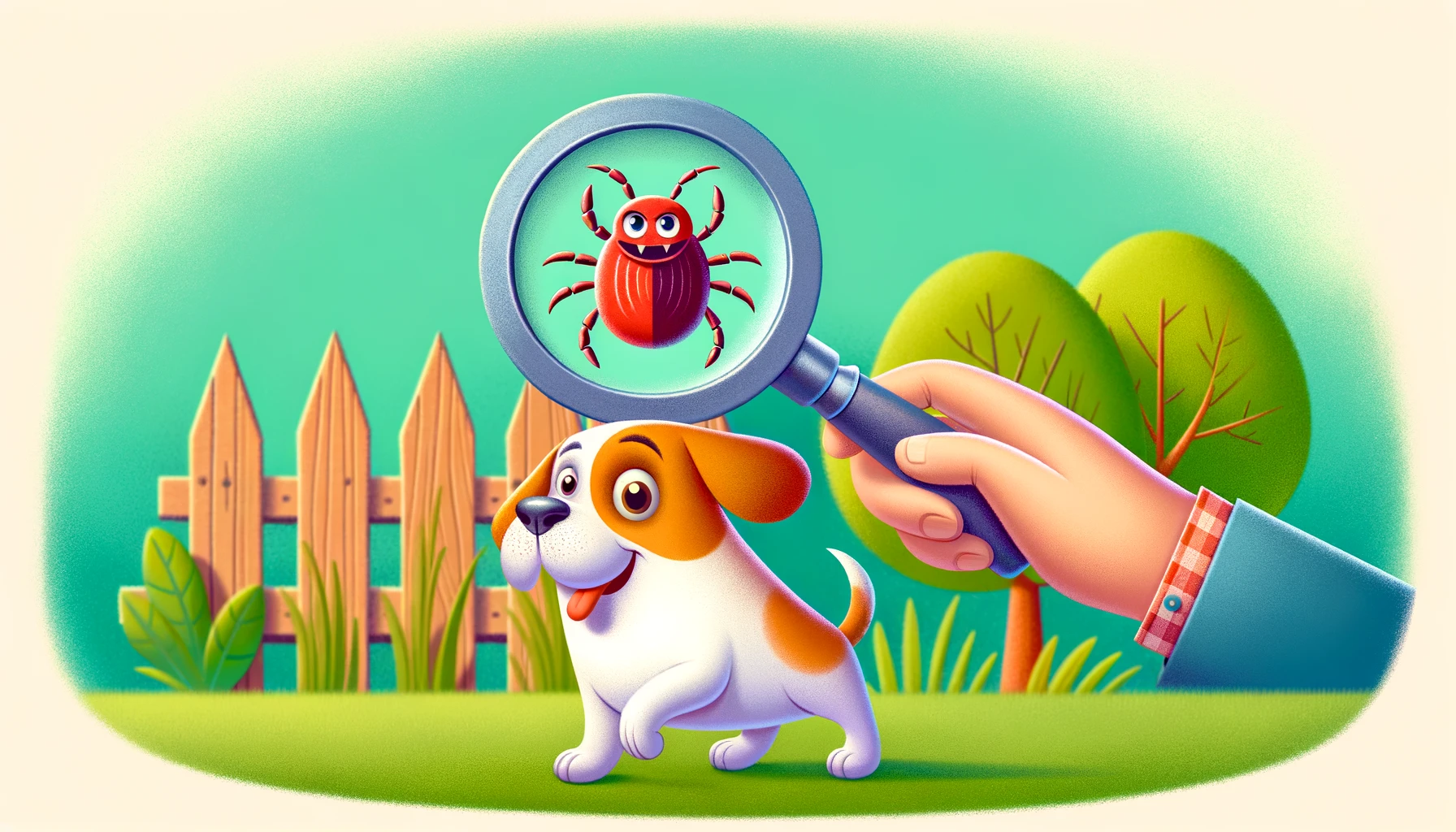The great outdoors! A place where your dog can frolic in the grass, chase squirrels, and – oh, what’s this? – host an impromptu gathering for ticks. Yes, ticks, nature’s freeloading hitchhikers, just love to catch a ride on your unsuspecting pooch. But fear not, dear pet owner, for I am here to guide you through the delightful process of tick removal.
Ticks 101 – Know Thy Enemy
Before we dive into the exhilarating world of tick removal, let’s take a moment to understand our adversary. Ticks are not just a nuisance; they’re like tiny, eight-legged uninvited guests that can bring a host of problems to your dog’s doorstep.
Ticks are arachnids (yes, distant cousins to spiders) and are experts in the art of stealth and survival. They don’t jump or fly; instead, they practice something called ‘questing.’ They perch themselves on the edge of a leaf or blade of grass with their front legs outstretched, waiting for an unsuspecting host (like your beloved dog) to pass by. Then, it’s dinner time.
Why Ticks Are Bad News – The Tiny Troublemakers
Ticks are dangerous because they’re not just bloodsuckers; they’re potential disease carriers. They can transmit a variety of illnesses to dogs, including:
- Lyme Disease: This is the celebrity of tick-borne diseases, and not for good reasons. It can cause fever, joint pain, and swelling in your dog. In severe cases, it can lead to more serious complications like kidney disease.
- Ehrlichiosis: Caused by the Ehrlichia bacteria, this disease can result in fever, weight loss, joint pain, and more. It’s like the flu, but worse, and it’s for dogs.
- Anaplasmosis: Similar to Lyme disease, it comes with fever, joint pain, and lethargy. Think of it as Lyme’s less famous but equally troublesome cousin.
- Rocky Mountain Spotted Fever: Despite its name, it’s not exclusive to the Rocky Mountains. Symptoms include fever, skin lesions, and, in severe cases, damage to the heart and kidneys.
Not all ticks are the same. Different types of ticks can carry different diseases. For instance, the black-legged tick (or deer tick) is notorious for transmitting Lyme disease, while the brown dog tick is a common spreader of Ehrlichiosis. It’s like a bad buffet, each tick offering a different unsavory dish.
Tick activity can vary depending on the season and your geographic location. They love warm, humid environments, but don’t be fooled – ticks can be active even in cooler months. It’s like they never take a vacation.
And now, armed with this information, let’s march onward to the battlefield of tick removal.
Removing a Tick
Step 1: The Discovery – Eureka! It’s a Tick!
Your first step in this enthralling journey is to locate the tick. This requires you to get up-close and personal with your dog’s fur. Think of it as a treasure hunt, but instead of gold, you’re searching for a tiny, blood-sucking parasite. Run your fingers through your dog’s coat with the precision of a skilled pianist, feeling for any unusual bumps. When you find a tick, resist the urge to scream in horror. Remember, you’re a brave tick-hunting warrior.
Step 2: The Gathering – Assemble Your Tick-Fighting Arsenal
Next, you’ll need to gather your tools. No, not a sword and shield – we’re not barbarians. You’ll need fine-tipped tweezers, gloves (to keep it hygienic), isopropyl alcohol, and a small container or ziplock bag. These instruments will aid you in your quest to banish the tick from your dog’s kingdom (i.e., its body).
Step 3: The Removal – Operation Tick Be Gone!
Now, the moment of truth. Approach the tick with the stealth of a ninja and the precision of a surgeon. Using your tweezers, grab the tick as close to the skin’s surface as possible. Pull upward with steady, even pressure. Don’t twist or jerk the tick; this can cause the mouth-parts to break off and remain in the skin. If this does happen, try to remove the mouth-parts with the tweezers. If you can’t, leave it be and let your dog’s skin heal.
After you’ve successfully extracted the tick, place it in your container or ziplock bag. You might want to show it to your vet, especially if your dog becomes unwell. Celebrate your victory, but remember, the battle might not be over. Ticks can be like bad movie sequels – sometimes there’s more than one.
Step 4: The Aftermath – Clean Up and Vigilance
Clean the bite area and your tweezers with isopropyl alcohol. Wash your hands thoroughly, even though you wore gloves. Gloves are like that friend who says they’ll help you move but then just ends up eating your pizza.
Finally, give your dog a treat. They’ve just been through a mini-ordeal and deserve some love. Plus, it’s a great way to apologize for any accidental hair-pulling.
Step 5: The Debrief – Lessons from the Frontline
So, you’ve removed the tick, and your dog is happily munching on a treat. Time to debrief. First, applaud yourself for not fainting at the sight of a tick. It’s a small, but significant, victory. Reflect on what you’ve learned. For instance, ticks don’t care about your dog’s pedigree. Whether your pooch is a street-smart mutt or a high-maintenance purebred, ticks are equal-opportunity annoyances.
Preventive Measures
Next, let’s talk prevention, because let’s face it, you’d rather not repeat this adventure. Let’s explore the smorgasbord of preventative options available, each serving as a mini-shield in your dog’s anti-tick arsenal.
1. Tick Collars – The Stylish Protector
Tick collars are like fashion accessories with a purpose. Infused with chemicals that repel or kill ticks, these collars are a popular choice for ongoing prevention. They’re relatively easy to use – just put it on your dog and forget about it for a few months. However, remember that their effectiveness can wane over time, and they might not be suitable for dogs that love to swim or get bathed frequently.
2. Topical Treatments – The Monthly Ritual
Topical treatments are like those skin-care routines everyone raves about. Applied directly to the skin, usually between the shoulder blades, these treatments spread over the dog’s body, providing a month-long shield against ticks. They’re great for dogs that aren’t keen on taking pills or wearing collars. The only catch? You need to remember to reapply it monthly, and there’s a no-pet zone for a day or two while it dries.
3. Oral Medications – The Invisible Force Field
Chewable tick preventatives are the incognito agents of the tick world. These oral medications, often flavored to entice your dog, are ingested and work from the inside out. They’re convenient, and there’s no mess or waiting period like with topical treatments. Plus, they’re ideal for water-loving dogs. However, they require a vet’s prescription, and you need to be spot-on with the monthly dosage.
4. Sprays and Powders – The Quick Fix
Tick sprays and powders are like the first-aid kits of tick prevention. They offer immediate protection and can be a good option for a sudden tick infestation or before a trip into high-risk areas. However, their effectiveness is usually shorter than other methods, and they require more frequent application.
5. Natural Remedies – The Eco-Warrior’s Choice
For those who prefer a more natural route, there are several eco-friendly options like essential oil-based sprays or homemade tick repellents. While these can be safer and more environmentally friendly, their effectiveness can vary greatly compared to chemical-based products. Always consult with your vet before going down this route, as some natural remedies can be harmful to pets.
Choosing the Best Option – Tailored Tick Defense
The best tick prevention method depends on your dog’s lifestyle, health, and environment. For the water-loving dog, oral medications might be the way to go. For the fashion-forward pooch, a tick collar could be just the thing. And for those with a strict monthly grooming schedule, topical treatments could be the perfect fit.
Remember, no one method is 100% effective, and sometimes combining methods (like using both a collar and a topical treatment) can offer the best protection. Always consult with your vet to find the option that suits your dog’s needs and lifestyle best. After all, when it comes to tick prevention, a tailored approach is often the most effective.
While ticks are an unpleasant part of pet ownership, dealing with them doesn’t have to be a nightmare. With a bit of preparation and a good dose of common sense, you and your dog can enjoy many happy, tick-free years together.
Pro Tips – The Insider’s Guide to Tick Mastery
Congratulations! You’re now well-versed in the art of tick removal and prevention. But before you go, let me arm you with some extra pro tips to elevate your tick-fighting prowess to legendary status.
- Regular Grooming – The Power of the Brush
Regular grooming is not just about keeping your dog looking dapper. It’s a powerful tool in the tick detection arsenal. Brushing your dog regularly helps you spot ticks before they settle in for a feast. Plus, it’s a great way to bond with your furry friend.
- Keep Your Yard Tick-Unfriendly – Gardening with a Purpose
Ticks love tall grasses and shady, moist areas. Keep your lawn mowed, bushes trimmed, and leaf litter at bay. Consider creating a tick-free zone around your home with gravel or wood chips – ticks are not fans of crossing these barriers.
- Tick Checks Post-Outdoor Adventures – The Essential Ritual
After any outdoor adventure, make it a habit to perform a thorough tick check on both your dog and yourself. Remember, ticks love to hide in sneaky places like between toes, behind ears, and under the collar.
- Know the Tick Hotspots – The Geographical Guide
Different areas have different tick species and risks. Educate yourself about the ticks common in your area and any tick-borne diseases prevalent there. This knowledge can help you be more proactive and vigilant.
- Immediate Action Post-Removal – Don’t Delay, Act Today
If your dog shows any signs of illness after a tick bite, such as fever, lethargy, joint pain, or loss of appetite, consult your vet immediately. Early detection and treatment of tick-borne diseases can make a significant difference.
- Store Removed Ticks for Identification – The Tick Library
After removing a tick, store it in a container with a piece of damp paper towel. If your dog falls ill, your vet can identify the tick type, which can be crucial in diagnosing and treating potential diseases.
- Keep an Eye on the Calendar – Timing is Everything
Many tick preventatives need monthly application. Set a reminder on your phone or calendar to ensure you don’t miss a dose. Consistency is key in keeping your dog protected.
- Training and Socialization – The Cooperative Canine
Train your dog to be comfortable with being handled and examined. This makes tick checks and removals much easier and less stressful for both of you. A dog that’s used to being touched and groomed will be a more cooperative patient.
- Be Tick-Aware on Travels – The Adventurous Precaution
If you’re traveling with your dog, especially to areas known for ticks, be extra vigilant. Research the local tick risks and take appropriate preventive measures before and during your trip.
- Share Knowledge – The Community Shield
Share your knowledge about ticks with fellow dog owners. The more people are aware and taking action, the safer our furry friends will be. It’s like creating a community shield against these pesky parasites.
FAQ – Tick Talk: Your Questions Answered
The sooner, the better. Ideally, you want to remove a tick within 24 to 48 hours after it attaches. The risk of disease transmission increases the longer the tick is attached.
Not immediately. Symptoms of tick-borne diseases typically appear days to weeks after a bite. However, it’s crucial to monitor your dog for any changes in behavior or health following a tick bite.
No breed is immune to ticks. However, dogs with thicker coats may provide ticks with more hiding places, making detection more challenging.
No. Human tick repellents can be harmful to dogs. Always use products specifically designed for canine use.
Daily checks are ideal, especially during tick season and after spending time in areas known for ticks.
It’s rare, but possible, especially if you live in an area with a high tick population. Regularly vacuuming and cleaning your home can help reduce the risk.
If the tick’s head breaks off in the skin, try to remove it with tweezers. If this isn’t possible, the dog’s body will likely expel it naturally. Keep an eye on the area for signs of infection and consult your vet if you’re concerned.
Yes, ticks can transmit diseases to humans, including Lyme disease. It’s important to protect yourself as well when handling ticks.
Not necessarily, unless you’re unable to fully remove the tick, the bite area looks infected, or your dog shows signs of illness.
Squishing a tick is not recommended as it can spread infectious fluids. Instead, drown the tick in rubbing alcohol or flush it down the toilet.



